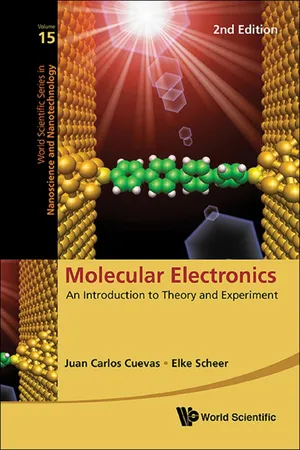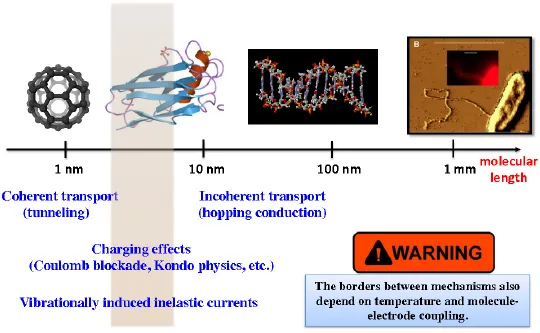
eBook - ePub
Molecular Electronics: An Introduction To Theory And Experiment (2nd Edition)
An Introduction to Theory and Experiment
- 848 pages
- English
- ePUB (mobile friendly)
- Available on iOS & Android
eBook - ePub
Molecular Electronics: An Introduction To Theory And Experiment (2nd Edition)
An Introduction to Theory and Experiment
About this book
Molecular Electronics is self-contained and unified in its presentation. It can be used as a textbook on nanoelectronics by graduate students and advanced undergraduates studying physics and chemistry. In addition, included in this new edition are previously unpublished material that will help researchers gain a deeper understanding into the basic concepts involved in the field of molecular electronics.
Frequently asked questions
Yes, you can cancel anytime from the Subscription tab in your account settings on the Perlego website. Your subscription will stay active until the end of your current billing period. Learn how to cancel your subscription.
No, books cannot be downloaded as external files, such as PDFs, for use outside of Perlego. However, you can download books within the Perlego app for offline reading on mobile or tablet. Learn more here.
Perlego offers two plans: Essential and Complete
- Essential is ideal for learners and professionals who enjoy exploring a wide range of subjects. Access the Essential Library with 800,000+ trusted titles and best-sellers across business, personal growth, and the humanities. Includes unlimited reading time and Standard Read Aloud voice.
- Complete: Perfect for advanced learners and researchers needing full, unrestricted access. Unlock 1.4M+ books across hundreds of subjects, including academic and specialized titles. The Complete Plan also includes advanced features like Premium Read Aloud and Research Assistant.
We are an online textbook subscription service, where you can get access to an entire online library for less than the price of a single book per month. With over 1 million books across 1000+ topics, we’ve got you covered! Learn more here.
Look out for the read-aloud symbol on your next book to see if you can listen to it. The read-aloud tool reads text aloud for you, highlighting the text as it is being read. You can pause it, speed it up and slow it down. Learn more here.
Yes! You can use the Perlego app on both iOS or Android devices to read anytime, anywhere — even offline. Perfect for commutes or when you’re on the go.
Please note we cannot support devices running on iOS 13 and Android 7 or earlier. Learn more about using the app.
Please note we cannot support devices running on iOS 13 and Android 7 or earlier. Learn more about using the app.
Yes, you can access Molecular Electronics: An Introduction To Theory And Experiment (2nd Edition) by Juan Carlos Cuevas, Elke Scheer in PDF and/or ePUB format, as well as other popular books in Technology & Engineering & Atomic & Molecular Physics. We have over one million books available in our catalogue for you to explore.
Information
PART 4
Transport through molecular junctions
Chapter 13
Coherent transport through molecular junctions I: Basic concepts
As we have just seen in Part 3, the level of understanding achieved in the field of metallic atomic-size contacts is certainly remarkable. However, it is also clear that such metallic nanowires are not very “flexible” in many respects. Thus for instance, their conductance can hardly be changed with a gate voltage and often their current-voltage characteristics are simply linear, which hinders the implementation of interesting electronic functionalities. Thus, it seems natural to investigate the use of molecules as possible building blocks of nanoscale circuits. Molecules are still small enough to take advantage of their size, and the great variety of their physical properties make them ideal not only to mimic ordinary components of today’s microelectronics, but also to provide new electronic functions.1 For these reasons, the analysis of the transport properties of molecular junctions is attracting a lot of attention and this will be the subject of the rest of this book.
The study of the transport properties of molecular junctions constitutes a formidable challenge. As we discussed in Chapter 3, there are still many basic problems to be solved from the experimental side: reproducibility of the results, stability of the contacts, external control, mass production, etc. On the other hand, the theoretical description of the electrical conduction in molecular circuits is, in general, considerably more complicated than in the case of atomic wires for various reasons. First, a molecule has a more complicated electronic structure than an atom, simply because it is composed of several atoms of, in general, different species. The accurate description of the interaction between those atoms which leads, among other things, to substantial charge transfer between them requires sophisticated ab initio methods.2 Second, in the case of a molecular junction, a molecule may have a weak chemical interaction with the metallic electrodes, which implies that the charge carriers can spend a long time in the molecule. This may in turn lead to the appearance of correlation effects well-known in mesoscopic physics such as the Coulomb blockade or the Kondo effect. Third, molecules possess internal degrees of freedom, in particular vibrations modes, which can be excited by the transport electrons leading to a modification of the current-voltage (I-V) characteristics. Obviously, the probability to excite a vibration depends on various factors like the strength of the electron-vibration interaction, the quality of metal-molecule interfaces and, of course, the length of the molecule. Depending on this latter factor, the vibrations can produce weak signals in the I-V curves in the case of short molecules or they can completely dominate the transport characteristics like in long DNA strands. Fourth, a molecule can undergo conformational changes due to, for instance, the high electric fields applied in the contacts, mechanical stress, an external field (electromagnetic radiation) or the local environment (red-ox reactions).
Due to the very rich phenomenology of molecular transport junctions, it is not an easy task to organize the existent material in the literature. Since this is not merely a review, we shall not follow a chronological order. Instead, we find more didactic to organize the huge amount of results concerning the physics and chemistry of molecular junctions according to the dominant charge transport mechanism. This dominant mechanism depends primarily on the length of the molecule (see Fig. 13.1), but also on the temperature and on the strength of the electrode-molecule coupling. In the case of small molecules (< 1-2 nm), one naively expects the transport to be fully coherent. This means in practice that electrons flow elastically (via quantum tunneling) through the molecules without exchanging energy and preserving the information about the phase of their wave functions. This will be the first topic to be discussed in what follows. In the coherent transport regime, the main goal is to understand the relation between the electronic structure of individual molecules and the transport properties of the junctions in which they are embedded. Our discussion of this topic will be divided into two parts. In the first one, which is covered in this chapter, we shall discuss several coherent transport phenomena that can be understood in the light of simple toy models or handwaving arguments. These phenomena include issues like the shape of the current-voltage characteristics, their temperature dependence, their symmetry or the dependence of the conductance on the length of the molecules. Then, in the Chapter 14, we shall address similar issues, but this time from a more quantitative point of view. In particular, we shall discuss the transport through short molecules that serve as test-beds for molecular electronics and we shall try to establish to what extend their electronic transport properties are quantitatively understood at present.

Fig. 13.1 Summary of the different transport regimes that can realized in molecular junctions. The dominant transport regime depends on the length of molecule, as illustrated in this figure, but it also depends on other parameters like the temperature or the strength of the coupling of the molecules with the electrodes. In the case of short molecules, the transport is expected to be coherent and this coherence can be broken by inelastic interactions like the Coulomb interaction or the electron-vibration interaction inside the molecule. As the molecular length increases, it becomes more likely for electrons to undergo inelastic interactions that completely destroy the quantum coherence and one enters in the so-called hopping regime where the transport is thermally activated. This is typically, although not necessarily, what happens in junctions based on biomolecules like proteins, DNA or bacterial nanowires. The figure of the bacterial nanowire was reprinted with permission from [1114]. Copyright (2014) National Academy of Sciences.
Inelastic interactions can destroy the quantum coherence giving rise to a diversity of physical phenomena. In Chapter 15 we shall discuss the transport through weakly coupled molecules, where correlation effects such as the Coulomb blockade and the Kondo effect play an essential role. Another inelastic interaction that can modify the transport properties of a molecular junction is the electron-phonon or electron-vibration interaction. For this reason, we shall present in Chapters 16 and 17 a thorough discussion of the role of vibrational modes in the current through short molecules. As the molecular length increases, the inelastic interactions become more efficient destroying the quantum coherence and in this case, the transport may still proceed in a series of incoherent, thermally activated, steps or hopping events. This is the so-called hopping transport regime that will be addressed in Chapter 18. In this chapter, we shall also discuss the phenomenology of biomolecular junctions, a topic of increasing interest nowadays.
Leaving the transport mechanisms aside, we shall devote Chapter 19 to the analysis of transport properties (different from the electrical conductance) that provide very valuable information about the transport in different types of junctions and conduction regimes. In particular, we shall address in that chapter the thermal transport in molecular circuits. In Chapter 20 we shall discuss the optical properties of current-carrying molecular junctions. Finally, in Chapter 21 we shall briefly mention some of the topics in molecular electronics that are not addressed in this monograph.
We want to stress that, as the previous part of this book, the remaining chapters have been written in such a way that most sections are accessible for both theorists and experimentalists. Our intention is to give a didactic introduction to the basic concepts in molecular electronics, but at the same time we have made an effort to review the most relevant contributions to the different topics in this field. Let us finally say that, as stated in the introductory part of this book, we shall mainly focus our attention on single-molecule junctions, but not exclusively.
13.1 Identifying the transport mechanism in single-molecule junctions
As explained in the introduction, in this chapter we want to discuss the coherent transport through molecular junctions. Let us stress that by coherent transport (or tunneling) we mean the transport regime in which the information about the phase of the wave function of conduction electrons is preserved along the molecular bridges and ...
Table of contents
- Cover page
- Title page
- Copyright
- Preface
- Acknowledgements
- Contents
- Brief history of the field and experimental techniques
- Theoretical background
- Metallic atomic-size contacts
- Transport through molecular junctions
- Appendixes
- Bibliography
- Index